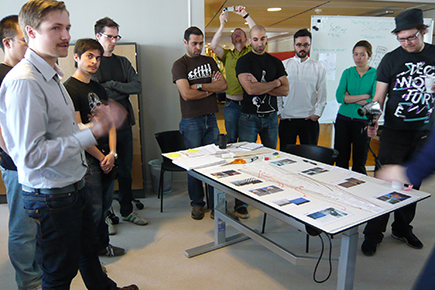Design Ethnography and Participatory Design, Umeå Institute of Design

This course introduced all first years to ethnographic and participatory design strategies. As a semester-long project course, the course is taught in the context of a design challenge – in 2008, this was the Interactive Institute's Switch! project. Switch! examines the presence and consumption of energy on a neighborhood, community, and citywide basis. It shifts away from the design of product interfaces and interactions in the home to larger scale and longer term energy issues in terms of household-household, building-building, neighborhood-neighborhood interactions. The project brief for the course was to develop an understanding of relations to energy in everyday life situations and to develop design proposals that draw attention to and encourage reflection on energy consumption. The course also introduced basic methodological concepts and skills, namely, ethnographic and participatory methods for design. The course as a whole guided the students towards developing a reflective understanding of the designer's role within inquiry and the critical application of such insights to a design proposal.
The context of the inquiry and practical work was local neighborhoods and cooperating households in the city of Umeň. In groups of three, students carried out the work in direct contact with local residents and participating families. Each group, with assistance from tutors, was responsible for managing their own relationships with design participants. From introductions, explaining the project, to coordinating schedules, students were challenged to build and maintain trust and confidence with their participants. During the project, each group held participatory design events to explore concepts with users through scenarios, sketches, mock-ups and low-fi prototypes among other materials. On the basis of this iterative process, each developed a design proposal for the final critique, communicated and justified by means of materials generated from the ethnographic and participatory inquiry process. Concepts were modeled or illustrated by means of 2- or 3-dimensional representations. Further, the 4th, or temporal, dimension was emphasized, and students were asked to project the role of the concept in everyday life, in social situations, and in affecting energy behaviors over time. Students were encouraged to use the final critique to ask questions and suggest further ethnographic, participatory, and design research that would be needed to develop their concept.
Level Masters (MA)
Credits 7.5
Dates 2008
Number of students 9
My role
One iteration of the course was co-taught by Brendon Clark, Camille Moussette and myself, with assistance from Basar Ínal. Brendon Clark and I were responsible for the theme and most of the syllabus and structure. I was responsible for introducing and supporting the project theme through lectures and tutorials, reviewing and providing feedback on ethnographic and participatory assignments, and conducting a workshop focused on participatory design methods.
The course was structured so that we would fly in to be present for intensive teaching periods of 2-3 days, with further tutoring via written feedback and video conferences. Camille Moussette was responsible for daily operations locally and a series of teaching sessions on video techniques and experience prototyping. The interim critique was held as a 2-day session hosted by Brendon Clark and myself at the Interactive Institute in Stockholm, in which a series of analytic and design activities was led by the students and by members of the Switch! team.
Image (above)
A presentation phase in the 2-day session held at the Interactive Institute
More about the school
Umeå Institute of Design
See also
/ Projects / Switch!